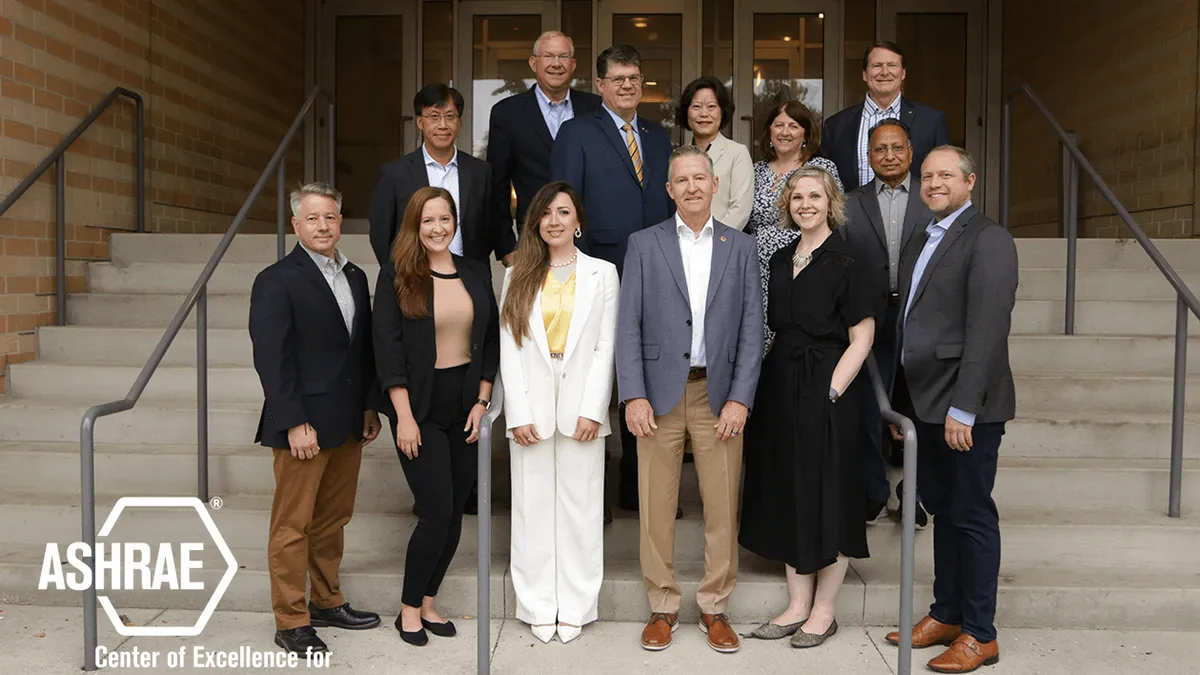Dive Brief:
- ASHRAE has launched the Center of Excellence for Building Decarbonization to drive the adoption of climate change mitigation policies and reinforce its goal of achieving net-zero greenhouse gas emissions in operation for all new buildings by 2030.
- The CEBD’s core activities will involve guiding ASHRAE’s building decarbonization efforts to integrate relevant goals into its strategic plan, track emerging issues and trends, provide policymakers and the public with reliable technical information on decarbonization, and coordinate joint initiatives, events and projects with other organizations, according to a news release Monday.
- “By making building decarbonization a focal point of our technical resources and advocacy, we are broadening our capacity to drive systemic change. CEBD signifies ASHRAE's dedication to empowering stakeholders with essential resources and educational opportunities and underscores our pivotal role in shaping a more sustainable future,” ASHRAE President Dennis Knight said in a statement.
Dive Insight:
The American Society of Heating, Refrigerating and Air-Conditioning Engineers’ Center of Excellence for Building Decarbonization will replace the ASHRAE Task Force for Building Decarbonization, a spokesperson for ASHRAE said. The TFBD was formed in the spring of 2021 to develop technical resources and provide leadership and guidance in mitigating the negative carbon impact of buildings on the environment, ASHRAE said in a release at that time.
Alongside the launch, the CEBD is releasing two technical guides — Decarbonizing Hospital Buildings and Decarbonizing Building Thermal Systems: A How-To Guide for Heat Pump Systems and Beyond. The guide for decarbonizing hospital buildings, which is available now, seeks to assist hospital facility managers, planners, architectural and engineering teams in reducing greenhouse gas emissions, ASHRAE said in the release.
The guide on building thermal systems will support design engineers and building operators in their decarbonization efforts, covering application, sizing, system configuration, refrigerants, electrical requirements and control strategies, the association said.
In addition, the organization has reinstated the ASHRAE Decarbonization Challenge Fund for a second year, according to the release. The fund is a year-long competitive grant program that seeks to implement decarbonization projects within local ASHRAE chapters.
Last year, 43 projects were submitted from 37 chapters, with nine projects awarded funding. These include the Nebraska chapter’s project on thermal envelope improvements at a community non-profit, which was awarded $10,000, and the Cincinnati chapter’s project on decarbonizing historic houses of worship through localized heating, which was awarded $4,250.
In late 2023, ASHRAE’s TFBD released the Grid-Interactive Buildings for Decarbonization: Design and Operation Resource Guide, which provides information on maximizing carbon reduction through building interactions with electrical power grids.
The launch of the CEBD follows the society’s announcement in February that it will work with U.S. energy service company Noresco to develop a technical decarbonization guide aimed at helping owners and operators of existing commercial and multifamily buildings cut GHG emissions. That guide is expected to cover building electrical loads, HVAC systems, distributed energy generation and hot water systems, Noresco said at the time.
In March, ASHRAE incorporated renewable energy into its latest building energy standard, 90.1-2022, following an affirmation by the U.S. Department of Energy. The DOE’s technical analysis estimates that implementing Standard 90.1-2022, the Energy Standard for Sites and Buildings Except Low-Rise Residential Buildings, would provide commercial buildings site energy savings of 9.8%, source energy savings of 9.4% and carbon emission reductions of 9.3% on a weighted national average.
Introducing renewable energy as part of this mix would increase those improvements to site energy savings of 14%, source energy savings of 14.7% and carbon emission cuts of 14.7%, according to estimates from the DOE.














